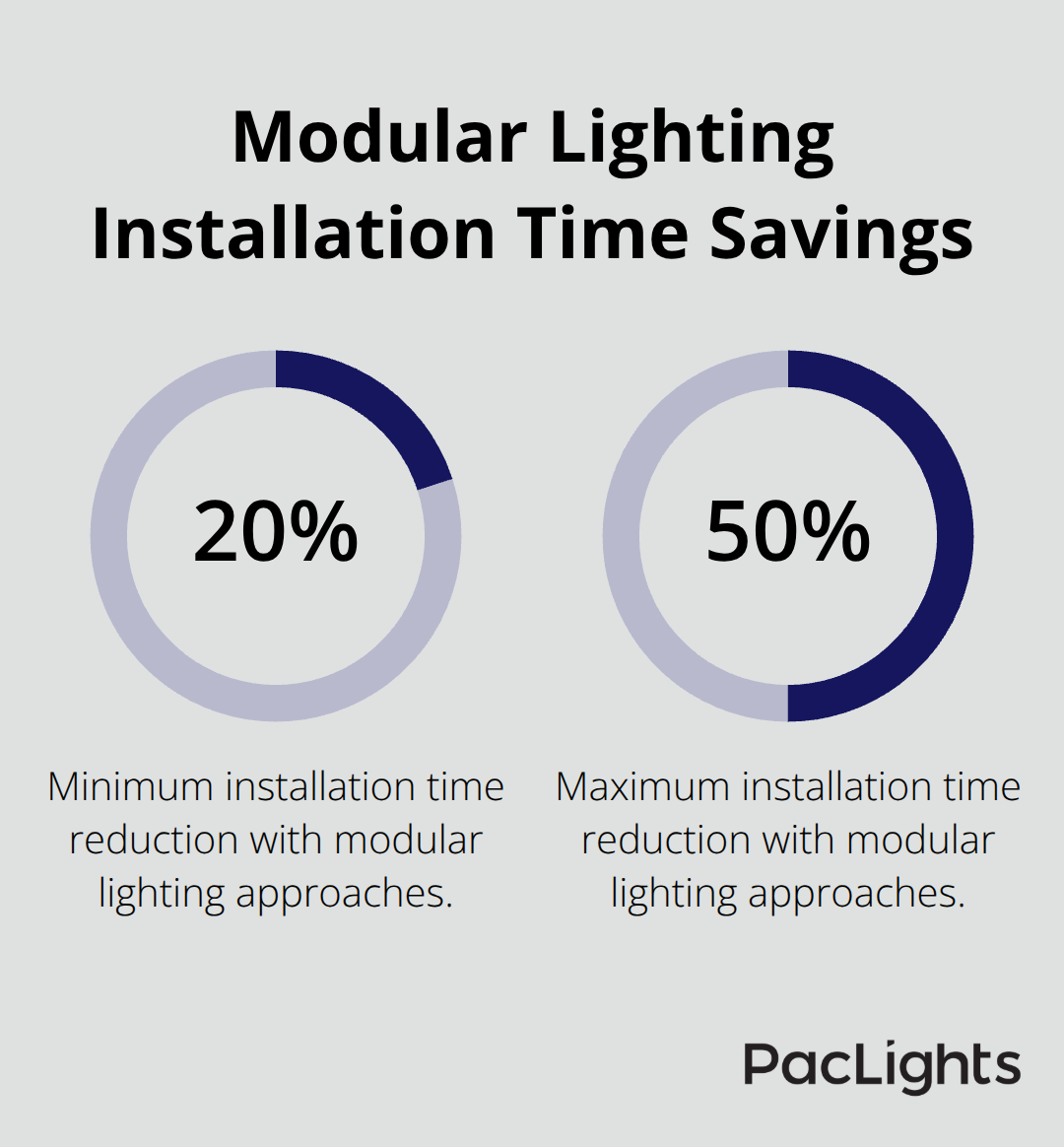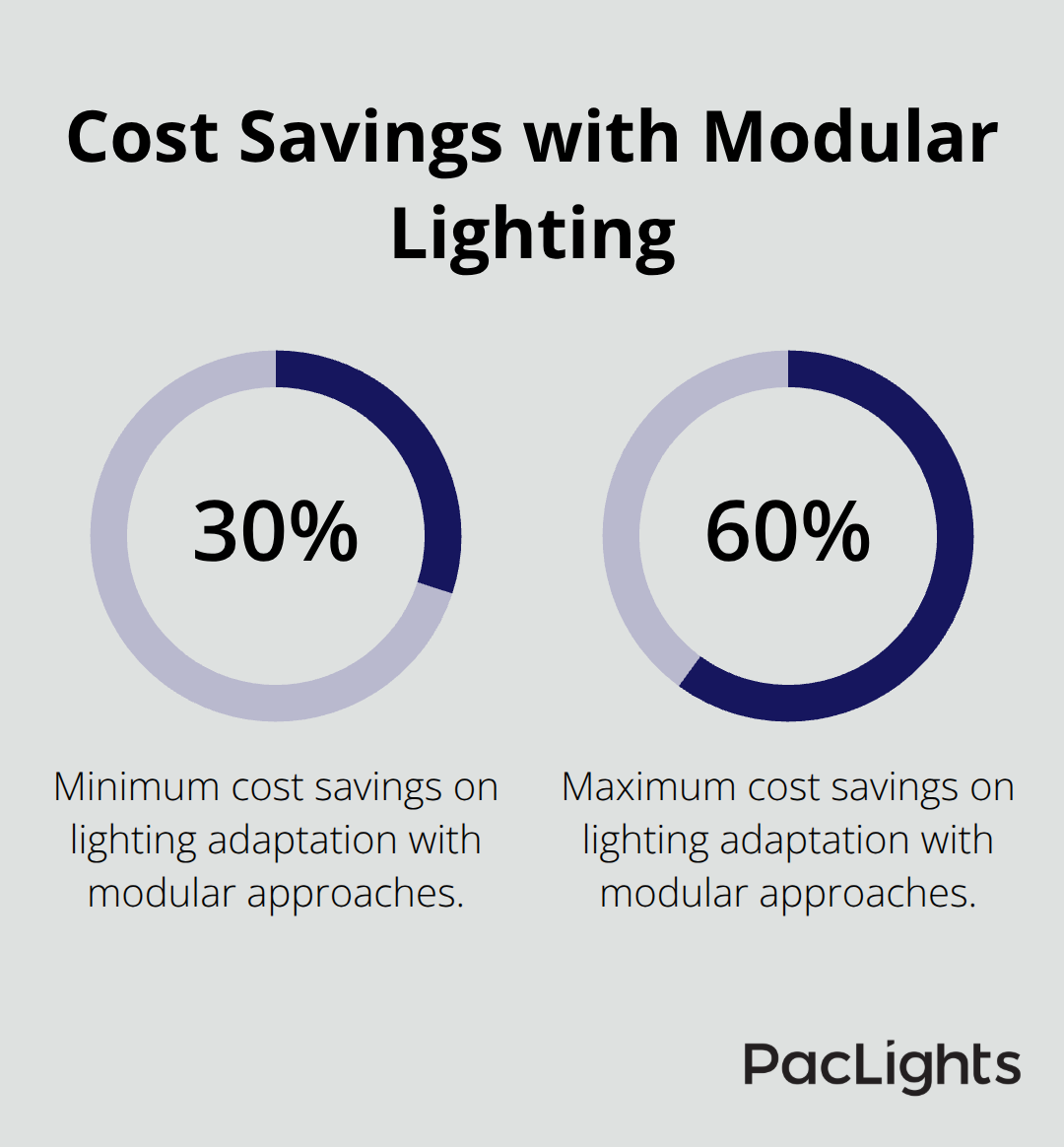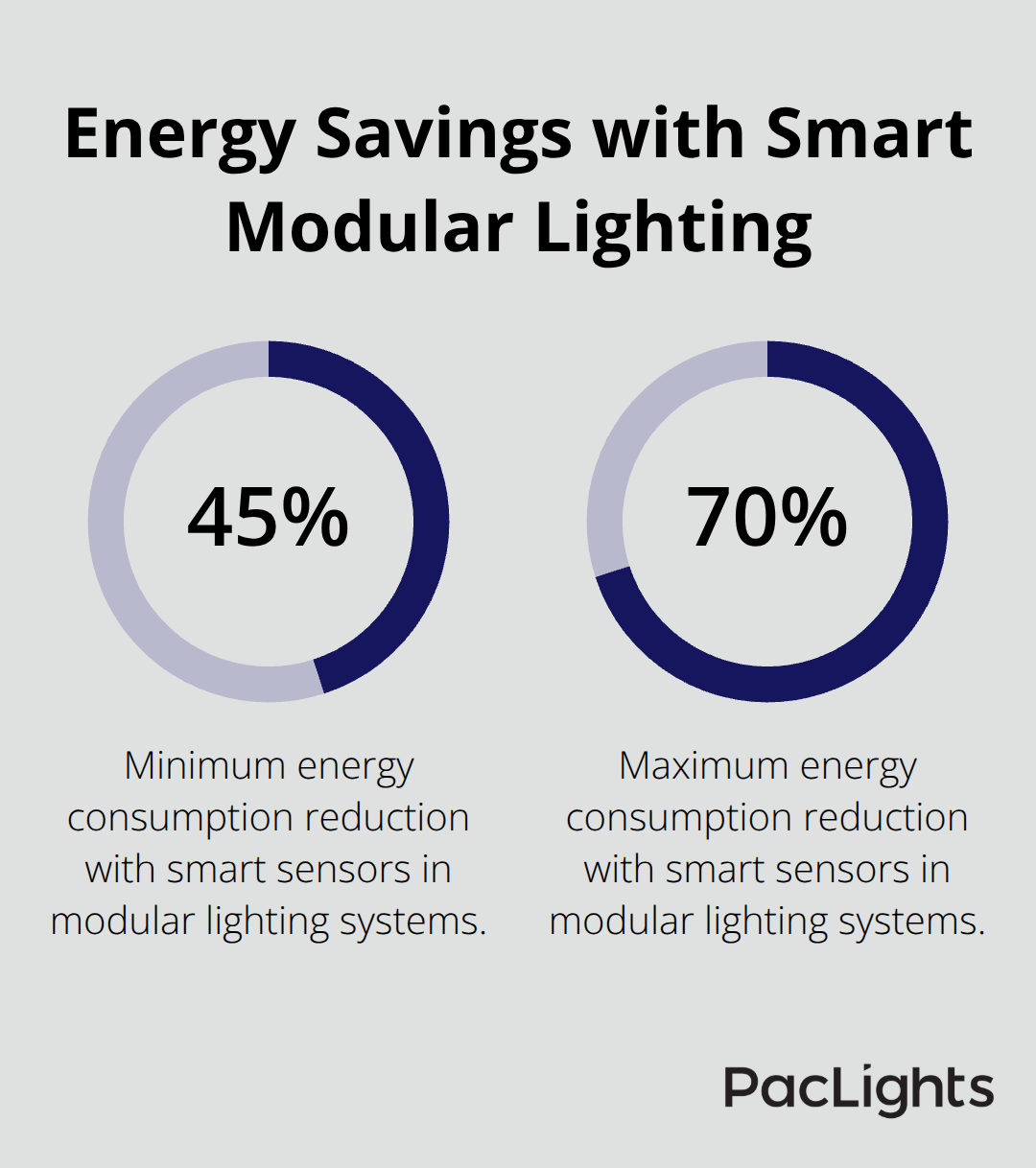Office spaces change faster than ever before. Companies relocate departments, expand teams, and reconfigure layouts monthly rather than yearly.
Traditional fixed lighting systems can’t keep up with this pace. We at PacLights see businesses struggling with expensive rewiring projects every time they need to adapt their workspace.
Modular office lighting offers a smarter solution that moves and adapts with your business needs.
What Makes Modular Lighting Different
Modular office lighting systems consist of interconnected components that snap together without permanent installation. Track systems, magnetic rails, and plug-and-play connectors form the foundation. Individual light fixtures attach to these rails through mechanical connections rather than hardwired electrical work. The McKinsey Modular Construction Report 2019 shows modular approaches reduce installation time by 20-50% compared to traditional methods.

Track Systems Lead the Market
Track lighting dominates modular configurations because it offers unlimited repositioning along continuous power rails. Linear track systems support downlights, spotlights, and pendant fixtures that slide and lock anywhere along the rail. Magnetic track systems use low-voltage power distribution (typically 24V or 48V), which allows fixtures to attach instantly without tools. Grid ceiling systems create two-dimensional flexibility where fixtures move both horizontally and vertically across suspended frameworks.
Smart Controls Transform Workspace Adaptation
Wireless control platforms like Casambi integrate seamlessly with modular fixtures and enable smartphone adjustments without rewiring. Motion sensors and daylight harvesting capabilities reduce energy consumption by approximately 50% compared to traditional LED solutions. Networked lighting controls allow zone-based programming where different areas maintain independent lighting scenes. Color temperature adjustment from 2700K to 6500K supports circadian rhythm optimization throughout workdays.
Performance Standards Meet Flexibility Demands
These systems maintain UGR ratings below 19 for visual comfort while they deliver CRI values above 90 for accurate color rendering. Quality manufacturers offer warranties up to 50,000 hours of operation, which matches traditional fixed installations. The modular approach doesn’t compromise on light output or distribution patterns that offices require for productive work environments.
This flexibility becomes even more valuable when you consider the installation process and long-term cost implications that businesses face with traditional lighting systems.
Why Choose Modular Over Fixed Lighting
Modular lighting systems deliver immediate operational advantages that traditional fixed installations cannot match. Office reconfiguration projects complete 40% faster with modular systems because they eliminate electrical contractor dependencies and permit instant changes. When teams expand or relocate within buildings, modular fixtures move with them immediately rather than require new electrical runs and ceiling modifications.
The Modular Building Institute reports that businesses save 30-60% on lighting adaptation costs through modular approaches compared to traditional rewiring projects. Installation disruption drops to near zero since modular systems operate independently of building electrical infrastructure.

Financial Impact Extends Beyond Installation
Maintenance costs decrease substantially with modular lighting because individual fixture replacement takes minutes rather than hours of electrical work. Energy management becomes granular when wireless controls allow zone-specific programming that matches actual occupancy patterns.
Smart sensors integrated with modular systems reduce electricity consumption by 45-70% according to recent energy auditing studies. The controlled factory production of modular components also minimizes material waste by 25% compared to site-built lighting installations.

Return on investment typically occurs within 18-24 months when businesses factor reduced installation time, lower maintenance requirements, and improved energy efficiency into their calculations.
Technology Integration Accelerates Workplace Evolution
Modern modular systems support real-time occupancy monitoring and automated daylight harvesting that traditional fixed lighting cannot accommodate without extensive retrofitting. Casambi-enabled fixtures allow smartphone control of individual zones while they maintain centralized energy monitoring across entire facilities.
Color temperature programming (from 2700K to 6500K) supports circadian rhythm optimization that improves employee alertness and reduces fatigue-related productivity losses. These technological capabilities become even more valuable when you understand how to properly assess your current space and plan for successful implementation.
How Do You Successfully Implement Modular Lighting
Successful modular lighting implementation starts with precise measurement and documentation of your current office footprint. Map existing electrical circuits, ceiling grid layouts, and furniture configurations with CAD software or detailed floor plans. Document current lighting levels with a light meter at desk height across all work areas – try for 500-750 lux for general office tasks according to Illuminating Engineering Society standards. Photograph problem areas where shadows, glare, or insufficient light impact productivity. This baseline assessment reveals exactly where modular systems will deliver the greatest improvement.
Calculate Load Requirements and Power Distribution
Determine total wattage requirements when you multiply square footage by 1.2-1.5 watts per square foot for LED modular systems. Identify existing 120V or 277V circuits that can support low-voltage track systems without electrical upgrades. Most magnetic track systems operate on 24V or 48V power supplies that connect to standard electrical outlets (which eliminates permit requirements and contractor dependencies). Plan power supply locations every 50-100 feet along track runs to maintain consistent voltage levels.
Plan Smart Building Integration
Smart building integration requires network connectivity through existing WiFi infrastructure or dedicated lighting networks like DALI or DMX protocols. Position network access points strategically to maintain reliable wireless communication with all fixture zones. Test signal strength throughout the installation area before you commit to specific track layouts.
Design for Growth and Reconfiguration Patterns
Analyze your company’s workspace changes over the past two years to predict future reconfiguration needs. Install track systems in grid patterns that support both current layouts and anticipated expansions – typically 8-foot or 12-foot spacing works for most office environments. Position power feeds at intersection points where multiple track segments meet to maximize flexibility. Wireless control zones should align with departmental boundaries rather than physical walls since teams relocate more frequently than permanent structures. It is advisable to work with a qualified electrician or lighting professional to ensure that the fixtures and controls are installed correctly and safely. Program lighting scenes that accommodate both focused work (4000K-5000K) and collaborative activities (3000K-4000K) within the same spaces.
Final Thoughts
Modular office lighting transforms how businesses approach workspace illumination. Companies achieve 30-60% cost savings on adaptations while they reduce installation time by 40% compared to fixed systems. Smart sensors integrated with these systems cut energy consumption by 45-70%, and investment payback occurs within 18-24 months when businesses calculate installation speed, maintenance savings, and efficiency improvements.
Future developments will enhance integration with building automation systems and artificial intelligence that predicts needs based on occupancy patterns. Color temperature programming will expand beyond circadian rhythm support to include productivity optimization algorithms that adjust throughout workdays. The controlled manufacturing process reduces material waste by 25% while wireless controls eliminate rewiring dependencies during reconfigurations.
We at PacLights see demand growth for networked lighting solutions that support current flexibility requirements and emerging smart building needs. Modular office lighting transforms illumination from a fixed infrastructure constraint into a dynamic tool that adapts with workplace demands. This approach positions businesses to respond quickly to changing space requirements without the delays and costs that traditional systems impose.


Disclaimer: PacLights is not responsible for any actions taken based on the suggestions and information provided in this article, and readers should consult local building and electrical codes for proper guidance.